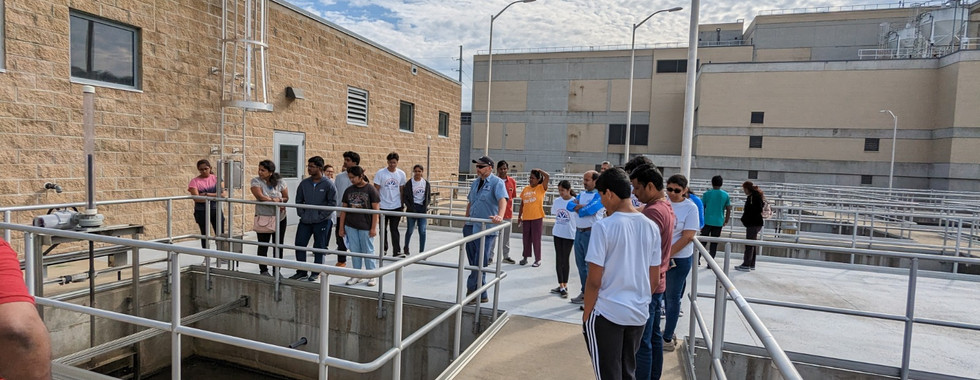‘’The way to bring about change is to be proactive and active ‘’ - Octavia Spencer
The VT Seva Detroit Youth Board conducted its first waste water treatment plant tour in Ann Arbor, MI on 4/16/2023 with 25 youth and adult volunteers participating.
It was such an interesting and eye-opening tour about what it takes to treat water that we consume and waste every day and the resources it takes to run the facility and amount of water that's treated each day. 𝐓𝐡𝐢𝐬 𝐟𝐚𝐜𝐢𝐥𝐢𝐭𝐲 𝐬𝐞𝐫𝐯𝐞𝐬 𝐚𝐫𝐨𝐮𝐧𝐝 𝟏𝟖𝟎,𝟎𝟎𝟎 𝐫𝐞𝐬𝐢𝐝𝐞𝐧𝐭𝐬 𝐚𝐧𝐝 𝐭𝐫𝐞𝐚𝐭𝐬 𝟏𝟖 𝐦𝐢𝐥𝐥𝐢𝐨𝐧 𝐠𝐚𝐥𝐥𝐨𝐧𝐬 𝐚 𝐝𝐚𝐲!
Kyle, who is the supervisor there, guided the tour of a facility. He explained the full process very well and answered all of our questions clearly. It was amazing to see how waste water becomes clean water again. The whole process takes over 24 hours. After the tour, Kyle presented a slide show and went over more of the technical details. A huge thanks to Kyle and Ann Arbor Water Treatment Plant for giving us this opportunity!
This tour did leave an impact on each one of us about how much water gets wasted every day and how many resources are needed to clean it again. Everyone who participated decided to make a change in their everyday routine to consume water more consciously.
Youth Volunteer Reflections:
I will not flush any disposable wipes as it will increase the amount of solids in the waste water. I will also not let water running when washing my hands, cleaning bowls, taking a bath (will not bathing for a long time), and not wasting water in general. I will also tell my friends about this and limit the water usage!
– Deekshitha Ravu
I will change myself by limiting the water usage whenever I am taking a bath.
– Hajanthan Muhinthan
I will try to take shorter showers to reserve water
- Hrudya Kishore
One thing that we should change is to avoid polluting the water and dumping waste into it. We need to use biodegradable and eco-friendly things.
– Nidhi Rao
I will take shorter showers to save water and reduce wastage
– Oviya Jaisankar
I was able to see a real world example of all 3 forms of science(chemistry, biology, and physics) and how they work in order to clean the water we use. I was able to take away that we need to be more mindful of what we put down our drains, as the smallest things can make the biggest impact in terms of sustainability.
– Rishi Adduri
I learned today is that we should use wet wipes because they aren't really biodegradable and will stop using them
– Shruthi Adduri
I would make sure to limit the amount of water I use.
– Vahini
One thing I will change is not disposing anything that I think is not biodegradable and may affect the wastewater treatment process, such as wipes.
– Varshan Muhinthan
I will try to be more conscious in daily my water use, like taking shorter showers and not leaving on the water when brushing my teeth.
- Veeksha
***************************
One of our parent volunteer Mr. Ranga Rao, captured all the technicalities in detail, so that any one can understand the process
Wastewater Treatment.
It is a process to remove waste materials from the wastewater (household, industrial and commercial), and the clean water can be used or returned into the regular water cycle. Whatever the waste removed from the sewage can be sent to landfill or the waste handling storage facility.
This process involves multiple stages:
1. Bar screening.
It is a preliminary level of filtration, being installed at the influent to a wastewater treatment plant. The simplest bar screens only have vertical bars that let water pass through while stopping big objects. It is a filtration process used to remove large objects, such as cloths, diapers, wipes and big metals and plastics from wastewater.

2. Grit chambers.
Grit chambers are long narrow tanks that are designed to slow down the flow so that solids such as sand, coffee grounds, and eggshells will settle out of the water. Settled down solid material can be removed easily.


3. Primary clarification.
It is a physical treatment process of removing solids, oil and grease materials before biological treatment. After the grit chamber process, water enters the clarifier tank and floatable solids (scum) are removed from the surface by skimmers while settleable solids (sludge) are collected on the bottom by a rake and removed via a sludge removal system.

4. Secondary treatment.
This process is performed by Bacteria and Protozoa in a managed aerobic or anaerobic process depending on the treatment technology. Bacteria and Protozoa consume biodegradable soluble organic contaminants (e.g., sugars, fats, and organic short-chain carbon molecules from human waste, food waste) from the sewage water. In this process air is pumped into the water.

5. Disinfection of Wastewater.
Ultraviolet light (UV), Chlorination, Ozone, and Chloramines are primary methods for disinfection of wastewater. UV light irradiation of wastewater would change the microorganism's DNA and they will not produce any harmful chemicals. After the UV light treatment, water can be safely released into the rivers.

Blog Edited By: Harish Jaisankar
Blog Published By: Nandini Cheemalamarri































Comentarios